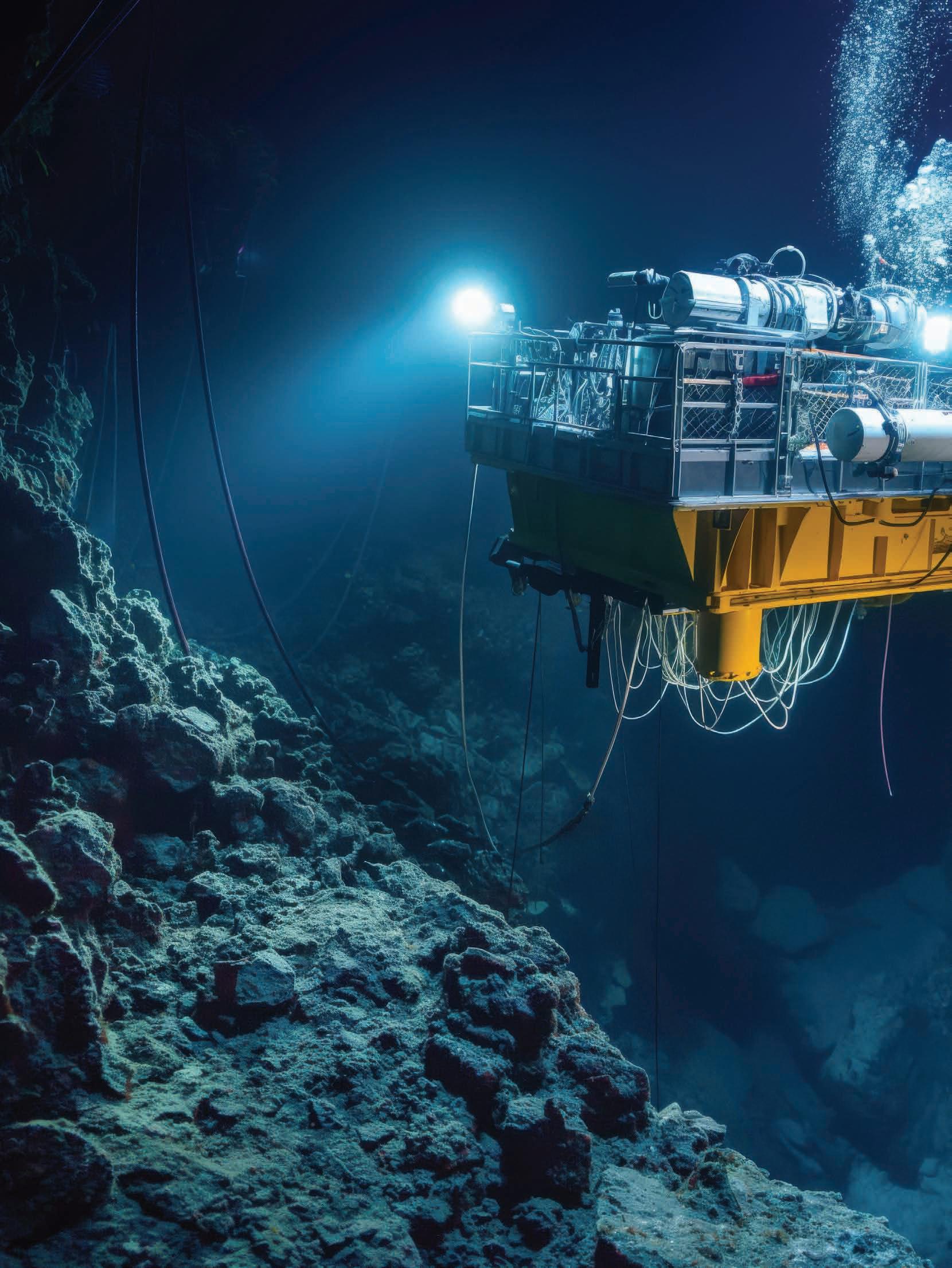
SPECIAL TOPIC


SPECIAL TOPIC
EAGE NEWS Welcome to Toulouse
CROSSTALK A voyage around TotalEnergies
TECHNICAL ARTICLE Characterisation of compacted sandstones


CHAIR EDITORIAL BOARD
Clément Kostov (cvkostov@icloud.com)
EDITOR
Damian Arnold (arnolddamian@googlemail.com)
MEMBERS, EDITORIAL BOARD
• Lodve Berre, Norwegian University of Science and Technology (lodve.berre@ntnu.no)
Philippe Caprioli, SLB (caprioli0@slb.com) Satinder Chopra, SamiGeo (satinder.chopra@samigeo.com)
• Anthony Day, NORSAR (anthony.day@norsar.no)
• Peter Dromgoole, Retired Geophysicist (peterdromgoole@gmail.com)
• Kara English, University College Dublin (kara.english@ucd.ie)
• Stephen Hallinan, Viridien (Stephen.Hallinan@viridiengroup.com)
• Hamidreza Hamdi, University of Calgary (hhamdi@ucalgary.ca)
Fabio Marco Miotti, Baker Hughes (fabiomarco.miotti@bakerhughes.com)
Susanne Rentsch-Smith, Shearwater (srentsch@shearwatergeo.com)
• Martin Riviere, Retired Geophysicist (martinriviere@btinternet.com)
• Angelika-Maria Wulff, Consultant (gp.awulff@gmail.com)
EAGE EDITOR EMERITUS
Andrew McBarnet (andrew@andrewmcbarnet.com)
PUBLICATIONS MANAGER
Hang Pham (publications@eage.org)
MEDIA PRODUCTION
Saskia Nota (firstbreakproduction@eage.org) Ivana Geurts (firstbreakproduction@eage.org)
ADVERTISING INQUIRIES corporaterelations@eage.org
EAGE EUROPE OFFICE
Kosterijland 48 3981 AJ Bunnik
The Netherlands
• +31 88 995 5055
• eage@eage.org
• www.eage.org
EAGE MIDDLE EAST OFFICE
EAGE Middle East FZ-LLC Dubai Knowledge Village PO Box 501711
Dubai, United Arab Emirates
• +971 4 369 3897
• middle_east@eage.org www.eage.org
EAGE ASIA PACIFIC OFFICE
EAGE Asia Pacific Sdn. Bhd.
UOA Centre Office Suite 19-15-3A No. 19, Jalan Pinang
50450 Kuala Lumpur
Malaysia
+60 3 272 201 40
• asiapacific@eage.org
• www.eage.org
EAGE LATIN AMERICA OFFICE
EAGE Americas SAS
Av Cra 19 #114-65 - Office 205 Bogotá, Colombia
• +57 310 8610709
• americas@eage.org
• www.eage.org
EAGE MEMBERS’ CHANGE OF ADDRESS
Update via your MyEAGE account, or contact the EAGE Membership Dept at membership@eage.org
FIRST BREAK ON THE WEB
www.firstbreak.org
ISSN 0263-5046 (print) / ISSN 1365-2397 (online)

3 EAGE News
17 Personal Record Interview — Mahad Nadeem Janjua
18 Crosstalk
21
Technical Article
27 Reservoir characterisation of compacted sandstones in the Osmancık Formation, Thrace Basin, Türkiye Taner Arpacı, İ smail Ömer Yılmaz, Serhat Akın and Emin U. Ulugergerli
Sp ecial Topic: Global Exploration
37 Egypt’s West Mediterranean Sea – a global exploration hotspot
Mark Hamilton
43 Oil and gas exploration hotspots in Asia Pacific: Data-driven opportunities in Malaysia, Indonesia, and India
Tad Choi, Nicolas Hand, Subodh Notiyal, Verity Agar and Duncan Woolmer
49 Global exploration – what role do hotspots play?
Bob Fryklund, Bill Mynatt and Clare Barkere
51 Intra-Draupne sandstone. Is it present in the Marulk Basin, just north of the Statfjord field?
Carl Fredrik Gyllenhammar
57 Ultra-deepwater: The lowest risk exploration
Neil Hodgson, Karyna Rodriguez and Lauren Found
61 The Pelotas Basin: A rising global exploration hotspot
Sindre Bull-Jansen, Javier Martin, Christian Strand, Karen Purcell and Mustafa Al-Waily
67 Supporting global exploration trends with geoscience insight
Erling Frantzen, Anna Lougon and Joe Zhou
75 What does the energy mix look like in a truly achievable transition and where will the secure energy needed come from to power the world?
Mike Lakin
86 Calendar
cover: Remotely operated vehicle searches for oil and gas resources in a deep sea environment. This month First Break showcases global hot spots.



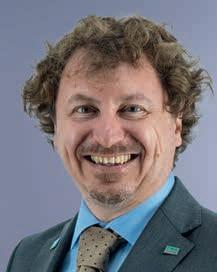






Andreas Aspmo Pfaffhuber Chair
Florina Tuluca Vice-Chair
Esther Bloem Immediate Past Chair
Micki Allen Liaison EEGS
Deyan Draganov Technical Programme Representative
Eduardo Rodrigues Liaison First Break
Vladimir Ignatev Liaison CIS / North America
Ruth Chigbo Liaison Young Professionals community
Gaud Pouliquen Liaison Industry and Critical Minerals community
Mark Vardy Editor-in-Chief Near Surface Geophysics
Martin Brook Liaison Asia Pacific
Madeline Lee Liaison Women in Geoscience and Engineering community
Yohaney Gomez Galarza Chair
Johannes Wendebourg Vice-Chair
Lucy Slater Immediate Past Chair
Wiebke Athmer Member
Alireza Malehmir Editor-in-Chief Geophysical Prospecting
Adeline Parent Member
Jonathan Redfern Editor-in-Chief Petroleum Geoscience
Xavier Troussaut EAGE Observer at SPE-OGRC
Robert Tugume Member
Timothy Tylor-Jones Committee Member
Anke Wendt Member
Martin Widmaier Technical Programme Officer
Carla Martín-Clavé Chair
Giovanni Sosio Vice-Chair
SUBSCRIPTIONS
First Break is published monthly. It is free to EAGE members. The membership fee of EAGE is € 85.00 a year including First Break, EarthDoc (EAGE’s geoscience database), Learning Geoscience (EAGE’s Education website) and online access to a scientific journal.
Companies can subscribe to First Break via an institutional subscription. Every subscription includes a monthly hard copy and online access to the full First Break archive for the requested number of online users.
Orders for current subscriptions and back issues should be sent to First Break B.V., Journal Subscriptions, Kosterijland 48, 3981 AJ Bunnik, The Netherlands. Tel: +31 (0)88 9955055, E-mail: subscriptions@eage.org, www.firstbreak.org.
First Break is published by First Break B.V., The Netherlands. However, responsibility for the opinions given and the statements made rests with the authors.
COPYRIGHT & PHOTOCOPYING © 2025 EAGE
All rights reserved. First Break or any part thereof may not be reproduced, stored in a retrieval system, or transcribed in any form or by any means, electronically or mechanically, including photocopying and recording, without the prior written permission of the publisher.
The publisher’s policy is to use acid-free permanent paper (TCF), to the draft standard ISO/DIS/9706, made from sustainable forests using chlorine-free pulp (Nordic-Swan standard).






I would like to take this opportunity to share with members that we are planning big changes for First Break in 2026 details of which we should be in a position to announce at the Annual in June.
The Board have accepted that, like many similar publications, sustaining a monthly printed version of the journal is no longer economically viable in terms of print, international distribution costs and advertising revenue trends. Digital publishing options have therefore been considered.
We believe that we have come up with a very dynamic solution that honours members’ expectations of First Break in terms
of providing first class technical content, industry news and analysis, and comprehensive coverage of our Association’s services, events, etc. At the same time the new format will provide additional opportunities for companies and organisations looking for exposure to our community through advertising, partnerships, sponsorships, etc.,
thereby meeting our revenue objectives. Furthermore, less printing, packaging and mailing of First Break aligns with our mission to reduce the carbon footprint of the Association’s activities.
We are proposing that beginning in 2026 there will be printed editions of First Break every quarter. This will be supported by an entirely reimagined online platform designed to provide a continuous reference point for members covering every aspect of our community in a variety of digital formats, the contents of which are under discussion but podcasts, videos, live coverage, etc. will certainly be in the mix linked where appropriate to the printed First Break and potentially EarthDoc.
Once we have established the basic model, we will be inviting you, our members, to participate in a survey to establish what kind of content you would like to see in the new set up.
I hope members will join me in being excited at this initiative which can greatly improve our communications as the role of geoscience and engineering adapts to the energy transition.
In anticipation of the upcoming changes, please be aware that this year there will only be nine printed issues of First Break. In the months of July, August, and December, the journal will only be available online, still published in the current format at the beginning of the month.
The annual Ballot to select the Board members is up and running, and we want you to be a part of it.
The Board plays a crucial role in shaping the direction of our Association and developing policies that serve your interests. Your participation in the ballot is important as it is when you have a say in how our Association operates on your behalf. Check your inbox for a personalised invitation with instructions on how to vote.
Here are this year’s candidates.

Mike Branston –
Vice President
Dr Mike Branston is a highly accomplished geophysicist with 27 years of global experience. He holds a BSc in Geophysics with Geology from Liverpool University and a PhD in Geophysics from Keele University, specialising in 4D microgravity and micro seismicity. In 2006, he was awarded chartered geologist status by the Geological Society of London.
In Dr Branston’s professional journey he has taken on pivotal roles in various countries, including Norway, Malaysia, the UK, and Qatar. Currently, he serves as the new energy domain lead at SLB Exploration Data, based in Kuala Lumpur, Malaysia. His role involves advising and supporting geophysical activities related to the new energy sector on a global scale.
Throughout his career, Dr Branston has been dedicated to designing technical solutions for subsurface imaging and monitoring challenges. He has published extensively and has been actively involved in several geophysical societies, primarily the EAGE. He has chaired and co-chaired numerous technical committees, including EAGE GET and PETEX conferences, and he has been a technical reviewer and session chair for EAGE and SEG annual conferences. Additionally, he has taught courses on advanced marine acquisition techniques for EAGE and SLB’s NExT.
Dr Branston is also a co-inventor of five patent applications related to carbon storage monitoring and has received funding for geophysical monitoring projects.

Timothy Tylor-Jones –
Vice-Chair Oil and Gas Geoscience Circle
Timothy Tylor-Jones is a senior geoscientist with over 21 years of experience. Currently a senior geophysicist and team lead at bp, he focuses on low-carbon gas projects for the energy transition. He actively involves in mentoring and building internal capability at bp.
Tylor-Jones is a chartered geologist and chartership assessor with the Geological Society and a certified petroleum geologist with AAPG. He is co-author of A Practical Guide to Seismic Reservoir Characterisation (Springer, 2023) and a regular EAGE contributor.
Tylor-Jones says: ‘I believe this Circle plays a vital role in advancing our profession, supporting technical excellence, fostering collaboration, and ensuring geoscientists are actively contributing to the energy transition.
I joined the Circle in October 2024 and, while early in my tenure, I’ve been a longtime supporter of EAGE and its mission to promote innovation, knowledge exchange, and professional fellowship. These values strongly reflect my own. I see the vice chair role as a chance to support the chair, help build momentum across our initiatives, and bring visibility to the great work being done by our members.’

Benjamin Bellwald –Vice-Chair Sustainable Energy Circle
Benjamin Bellwald is a senior geoscientist with 13 years of experience in managing complex projects related to low-emission challenges, marine geohazards, geotechnical analysis for seabed infrastructure, seabed and subsurface characterisation, seabed engineering, and technology development. Skillset includes excellent leadership, complex data interpretation and integration, data acquisition, inter-disciplinary result dissemination and high-impact publication.
Bellwald holds a bachelor degree in climate and water and a master degree
in geology and geochemistry from ETH Zurich, and a PhD in marine geology and geophysics from University of Bergen.
Bellwald says: ‘I am currently co-chairing the EAGE Wind Energy Technical Community, and have previously been a committee member of the EAGE Special Interest Community on Decarbonization and Energy Transition. I am excited to contribute to and present myself in the role of vice-chair, Sustainable Energy Circle.’

Eric Verschuur –Publications Officer
Eric Verschuur received his MSc in applied physics in 1986 and his PhD with honors in 1991, both from TU Delft. He is currently an associate professor in the Department of Geoscience at TU Delft.
Since 2016, he is the program director of the Delphi research consortium. His research focuses on geophysical exploration and monitoring for the energy transition and subsurface applications.
In 1997, he received the J. Clarence Karcher Award from SEG, and in 2006, he was honoured with the SEG’s Virgil Kauffman Gold Medal. He served as an associate editor for Geophysics from 2003 to 2013 and is currently on the editorial boards of the Journal of Seismic Exploration and the Journal of Geophysics and Engineering
Since 2006, he has been a member of the EAGE Research Committee (chair 2013-2016). He was selected as the lecturer for the inaugural EAGE Education Tour in 2006, delivering a course on multiple removal, which he has since presented more than 50 times around the world.
Verschuur says: ‘As publications officer, I have the opportunity to contribute to this vital aspect of the EAGE organisation. My goal is to maintain the high standards of our scientific publications while ensuring that our First Break remains a vital pillar of delivering insightful and impactful articles to our community. Additionally, I will strive to achieve a balanced approach between physical and electronic publications to best serve our members.’


DUG MP-FWI IMAGING FOR NEAR-SURFACE RESOLUTION
DUG MP-FWI Imaging uses the entire wavefield, including all free-surface multiples. Multiples, normally considered as problematic noise (especially in a shallow-water setting), illuminate the subsurface in complementary ways to primary reflections. The result is that the subsurface is sampled far more completely, and with a wider range of angles.
More signal. Higher resolution. Superior imaging. How illuminating!
info@dug.com | dug.com/fwi
This legacy dataset (late 1990s) was not acquired with shallow high-resolution in mind. It’s a conventional towed-streamer acquisition in a shallow-water environment.
On 2–5 June 2025, we’ll welcome geoscientists and engineers from around the world to the MEETT Toulouse Centre for a week of innovation, learning, and connection under the theme Navigating Change: Geosciences Shaping a Sustainable Transition. Here’s a checklist of what you can expect.





EAGE Annual 2025 opens with a high-level session featuring leading voices in energy, tackling key industry topics and celebrating excellence in geoscience and engineering through prestigious awards.
The heart of EAGE Annual 2025 lies in its rich and diverse Technical Programme, shaped by leading experts and built on high-calibre submissions from around the world (see interview on page 7 with Martin Widmaier, our Technical Programme Officer).
Discover what’s next in geoscience at the EAGE Exhibition, where over 200 exhibitors, ranging from industry leaders to innovative start-ups, will be showcasing cutting-edge tools, technologies, and research. Be sure to check out the theatre talks focused on Digital Transformation




and Energy Transition, offering fresh perspectives on the shift to smarter operations and a sustainable energy future.
Before and after the main event, dive deeper with hands-on Workshops, Field Trips, Short Courses, and the popular Hackathon, running Sunday, Monday, and Friday. Whether you’re expanding your expertise or exploring new ground, these sessions offer a chance to learn from industry leaders, connect with peers, and put your skills into action.
EAGE Annual is a great moment for our community and students to come together, share ideas, and get inspired. Drop by the Community Hub for meetups, discussions, and activities designed to support learning and career growth.

Networking is one of the highlights everyone looks forward to. Whether it’s the Icebreaker Reception, the lively Conference Evening at Victor Hugo Market, or relaxed catch-ups over drinks and lunch, there are plenty of chances to connect. Registered guests (your partner and family members) can join in too, with access to all the main events and a special tour of Toulouse.
Visit eageannual.org for full details and to register. You can sign up for the full week, per day, or choose Conference or Exhibition only. To make the most of your time, consider the All Access package –it includes workshops, field trips, short courses, the hackathon, plus the Conference, Exhibition, Icebreaker Reception, and Conference Evening. Register before 15 May 2025 to take advantage of discounted fees!
Technical Programme Officer Martin Widmaier (vice president, geophysical support, TGS), explains why the Technical Programme at the Annual in Toulouse will be special.
Tell us about this year’s theme. Our chosen theme – Navigating Change: Geosciences shaping a sustainable transition – is very well reflected in the Technical Programme. We continue to facilitate knowledge transfer and technology development related to hydrocarbon exploration and production, i.e., energy security, while increasingly promoting the role and responsibility of the geoscientific and engineering communities with respect to renewable energies and a sustainable future.
What would you pick as the highlights this year?
Three highly relevant and popular themes stand out in this year’s Technical Programme: full waveform inversion (FWI), carbon capture and storage (CCS), machine learning (ML) and artificial intelligence (AI). FWI technology is making a huge impact on improved velocity building and subsurface imaging in geologically complex areas. The FWI-related sessions will cover recent advances in technology and the latest case studies from many basins. The sessions with a CCS theme will cover the full range from screening and site characterisation to site operations and monitoring. The high number of paper submissions related to ML and AI demonstrate that our industry is fully committed to the digitalisation path. The ML and AI sessions focus

on the separate disciplines to which the technology can be applied.
How does this year’s programme compare with recent Annuals?
The EAGE Annual Conference in Oslo last year in particular was a great event with a balanced programme covering many disciplines. The preparations for Toulouse will follow this successful recipe with only minor adjustments. However, I would highlight two notable changes.
First, TotalEnergies as host sponsor has made a significant contribution to this year’s event. The company was responsible for forming the Local Advisory Committee (LAC) with partner sponsors and invited industry representatives. The LAC worked on strategic programme aspects, discipline expansion, and added regional content facilitated by the French geoscientific communities.
Secondly, EAGE and SEG will emphasise the collaboration between the associations. EAGE has incorporated the four best papers from IMAGE 2024 into the schedule, and SEG/AAPG will follow with a ‘Best of EAGE 2025’ session at the IMAGE 2025 conference later this year.
How far does the programme accommodate EAGE’s three Circle member structure?
The technical programme clearly reflects the evolving focus and interests of EAGE’s three Circles, as it should! The Circle chairs – Yohaney Gómez Galarza (Oil and Gas), Andreas Pfaffhuber (Near Surface), and Carla Martín-Clavé (Sustainable Energy) – are members of EAGE’s Technical Programme Committee (TPC). As defined in EAGE’s by-laws, the three Chairs, together with me, ensure that we represent and support a wide range of disciplines. The Technical Programme also shows the positive impact of EAGE’s Technical Communities. Their members have been very active

in proposing and planning workshops and dedicated sessions.
Are there new topics or trends being introduced this year?
Sustainable energy and energy transition-related topics continue to be the most prominent trends and growth areas. I have already mentioned the CCS sessions as one of the Programme’s highlights. Additionally, geothermal exploration and geothermal technologies will be a ‘hot’ topic. Last but not least, hydrogen as well as critical minerals, will be addressed during the conference. For example, we will have a dedicated session about exploration and production of unconventional lithium.
How does the Programme relate to our professional community?
Along with the Exhibition, pre- and post-convention workshops and the strategic agenda, the Programme should be very compelling for everyone - from senior management representatives to subject matter experts and our young professionals. It offers both learning and networking opportunities, and there is a lot of innovation and technical progress ongoing that is waiting to be shared amongst our professionals.
‘EAGE-Agents’ sounds like something from a Bond movie. In fact, it is the Hackathon being planned by our Technical Community on Artificial Intelligence on 1-2 June in Toulouse ahead of the Annual.
The mission, should you choose to accept it, will be designing, testing, and implementing agentic AI applications capable of autonomously processing real-world seismic data.
Not sure if this challenge is for you?
Giuseppe Amendola and Matthieu Guillouet, winners of the Hackathon ‘Coding to Net-Zero: AI for energy-efficient future’ last year in Oslo, recall their experience.
What motivated you to join the EAGE Annual Hackathon?
We were driven by the chance to collaborate with professionals from diverse backgrounds, tackle real-world challenges in geoscience and engineering, and develop innovative solutions using data science

and machine learning. The hackathon provided a dynamic setting to experiment with new ideas, learn from peers, and push the boundaries of problem-solving in our field.
What did you develop?
We came up with a generative AI solution for geoscience data called GeoEmbed. This is an AI agent designed to create robust and efficient embeddings for geoscience applications. By analysing patterns in seismic images, well logs, attribute maps, and text descriptions using advanced AI models like vision transformers, it enables various applications. For example, it can identify features in seismic data, such as gas chimneys or DHIs (Direct Hydrocarbon Indicators), using text or images as input.
How was the experience for you?
Throughout the hackathon, we learnt from highly skilled professionals who introduced us to cutting-edge AI challenges and solutions. Our project allowed us to explore new technologies, such as fine-tuning large GenAI models, giving us hands-on experience with the latest

advancements. Not only did this broaden our technical expertise but also deepened our understanding of the ongoing AI revolution and its impact on geoscience and engineering.
The EAGE Annual Hackathon 2025 offers a unique chance to explore how AI can transform seismic data processing. Whether you’re an experienced coder or new to AI, the event presents tailored challenges that foster creative thinking and practical implementation.
To accept the Hackathon challenge, sign up at eageannual.org.

Jan de Bruin (JdB VitalSeis) discusses his new short course being presented at the Annual meeting on Sunday 1 June.
Tell us about the ‘fresh look’!
The course does not shy away from highlighting problems with compressive sensing (CS) in seismic acquisition. Almost everything, at least everything I have been able to find in the literature about CS, is in the range from mildly positive to extremely positive, such as ‘a revolution in signal processing’ or ‘a new paradigm’.
I can give an independent analysis because I have no vested interest in companies either using CS or not using it. The course intends to explain, not to ‘sell’ a technology.
How does the course balance math and common language?
One expert in CS admits he can’t explain it but ‘there’s a ton of math behind it’. This course explaions it but saves people the rather significant amount of time needed to go through the math that’s behind it by using common language and logical arguments. This is why the course can fit into one day. At the end of the math, there are conclusions many of which are true, and there are lemmas that are actually proven, but not all of them apply to seismic acquisition, and not even all of them apply to the other areas where CS claims success, for example, megapixel camera pictures and MRI. The course is probably the only place right now where people can find out about the shortcomings.
How has your experience shaped your perspective on the practical application of CS in geophysics?
It is more my background in physics that counts here, and an understanding of how best to measure things (such as the wavefield). CS is mainly relevant in seismic acquisition. Processing has the task to deal with data that has been acquired using CS, which I and some others claim is not fundamentally different from interpolation, but is called ‘reconstruction’. Interpreters should, if CS has worked as promised, not notice any difference other than a significant reduction in cost.
What kind of debates do you hope participants will bring to the table, and how do you see these shaping the learning experience?
Which debates could unfold depends largely on the audience. There may be people who have used CS, who can share their experience; people who are considering using CS and have questions about it; people who are excited about CS after reading about it; as well as people who are sceptical about CS. There will likely be plenty of scope for discussion, but presenting the course material will take priority (and take at least some 80% of the time).
Course details at eageannual.org.
Mark your calendar for the Annual General Meeting for Members (AGMM) in Toulouse taking place on Wednesday 4 June 2025 from 13:30 to 14:30. This is your opportunity to meet the EAGE Board, learn about the activities of the past year and contribute to shaping the future of EAGE. We encourage members to attend and share their thoughts, ideas and feedback. Visit eage.org/about eage/ agmm for more details. We look forward to seeing you there!
Simulate your target before you fly

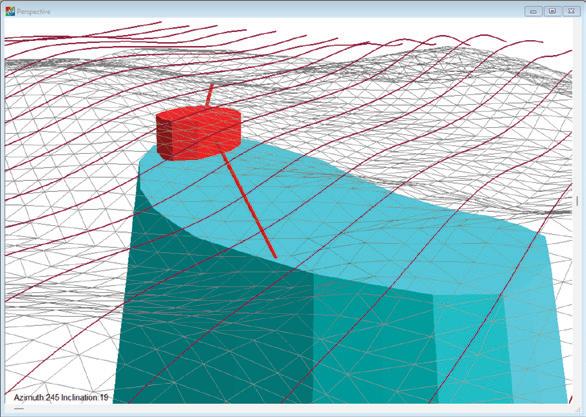


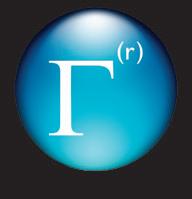
Naples (Napoli), the host city for this year’s NSG, is a true geoscience treasure. Its unique geological landscape and historical challenges provide fascinating real-world examples for each of the conference’s main tracks. Here’s a guide.
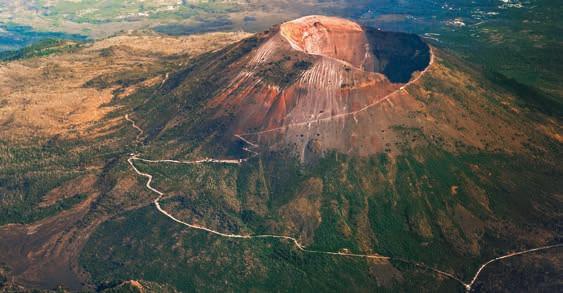
The 31st Meeting on Environmental and Engineering Geophysics offers a broad forum to explore the full spectrum of near-surface applications: an opportunity to connect your work with that of the multidisciplinary EAGE near-surface community. With topics spanning from geothermal energy to archaeological investigations, the programme resonates strongly with the Naples region, where a dynamic geological setting and rich cultural heritage provide an inspiring backdrop for discussion.
Geohazards assessment and risk mitigation
is bradyseism, a cyclical ground uplift and subsidence, particularly evident in the town of Pozzuoli (just 15 km from the city centre of Naples). This phenomenon has gained deeper scientific attention in recent times, particularly as a new phase of unrest has emerged since 2011, after 26 years of subsidence, making Pozzuoli a global case study for monitoring and understanding natural hazards.
UXO and object detection
This topic resonates with many projects around Naples, such as a recent call for the removal of unexploded ordnance at the San Giovanni di Dio e Ruggi d’Aragona new hospital development. Operations like this highlight the need for precise detection technologies to ensure public safety and smooth progress, particularly in project areas with historical contamination risks.
Mineral exploration and mining
Naples’ rich volcanic history is exemplified by historical deposits of pumice and pozzolana. These materials, prized since Roman times for their lightweight properties and use in high-quality con-
was particularly valued for its ability to strengthen cement through its reaction with lime. These deposits remain significant not only for their historical use but also for their continued application in sustainable building practices today.
Infrastructure planning, monitoring and BIM
Here we have a critical issue for Naples’ complex ground composition and historic urban layout. The excavation works for Naples Metro Line 1, for instance, unearthed a number of archaeological finds spanning various historical periods, in addition to confronting challenges related to layers of volcanic ash, pumice, and soft soils. These discoveries were made possible through meticulous geophysical surveys that identified buried structures, enabling engineers to adapt construction plans accordingly. This not only prevented potential structural issues related to unstable ground but also safeguarded Naples’ rich archaeological heritage, integrating it into the modern urban face of the city.
Join us in Naples this September to dive into five dynamic conferences, all in one vibrant location. Visit eagensg.org for more details.




Every month we highlight some of the key upcoming conferences, workshops, etc. in the EAGE’s calendar of events. We cover separately our four flagship events – the EAGE Annual, Digitalization, Near Surface Geoscience (NSG), and Global Energy Transition (GET).

First EAGE Workshop on Energy Transition in Latin America’s Southern Cone 17-18 September 2025 – Buenos Aires, Argentina
The global energy transition is evolving rapidly, and the Southern Cone of Latin America has immense potential to drive innovation and sustainable solutions. This first workshop will bring together industry experts, researchers and policy makers to discuss the latest developments in geological hydrogen, offshore wind, geothermal, CCUS and other key issues shaping the future of energy. We invite professionals from academia and industry to present technical papers and share their views on innovative research, emerging technologies and success stories from the region and beyond.
Abstract submission deadline: 20 June 2025.
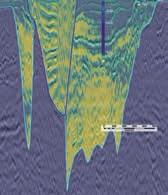
3rd EAGE/SUT Workshop on Integrated Site Characterisation for Offshore Renewable Energy 15-16 October 2025 – Melbourne, Australia
The EAGE and the Society for Underwater Technology (SUT) are collaborating on this workshop initiative to enhance the integration of geoscience and engineering disciplines in delivering robust site characterisation for offshore renewable energy projects. The need for multi-disciplinary collaboration has never been greater. The workshop will explore regional geo-engineering challenges, regulatory considerations, and investment landscapes, offering key takeaways for developers, contractors, consultants, and academics. Key topics include regulatory considerations, project challenges, lessons learned, technology updates, and case studies on integrated site characterisation.
Abstract submission deadline: 20 June 2025.

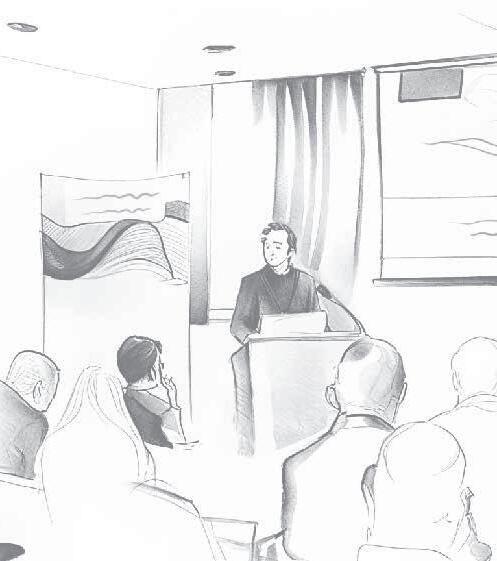
EAGE/AAPG Workshop on Tectonostratigraphy of the Arabian Plate 2-5 November 2025 – Riyadh, Saudi Arabia
The workshop offers an in-depth exploration of the tectonostratigraphic framework of the Arabian Plate, focusing on the tectonic forces that have shaped the region’s lithostratigraphy and its geological history. Participants will gain a comprehensive understanding of structural geology, sequence stratigraphy, and techniques for interpreting geological maps and cross-sections. Through a mix of lectures, hands-on activities, and field-trip exercises, attendees will acquire skills to analyse and identify key structural features of the Arabian Plate. A highlight of the workshop will be the two-day field trip to Riyadh, visiting the East Janadriyah and Umm-Shual anticlines.
Abstract submission deadline: 5 May 2025.

First EAGE Workshop on Surface Logging 12-14 November 2025 – Paris, France
Surface logging plays a pivotal role in modern well construction, providing real-time data that enhances operational safety, efficiency, and decision-making. As digitalisation and cross-disciplinary collaboration advance, surface logging is gaining increasing attention. This workshop will explore surface logging technologies and their applications, improving subsurface understanding, optimising well operations, and reducing operational risks. It will cover how surface logging integrates geological, petrophysical, and drilling data to improve well placement, reservoir evaluation, and hazard detection. Additionally, the workshop will highlight its growing relevance in energy transition, with applications in unconventional resources, geothermal wells, and emerging gas exploration.
Abstract submission deadline: 15 June 2025.
The four key technologies – Carbon Capture & Storage (CCS), Geothermal, Hydrogen & Energy Storage, and Offshore Wind – are deeply interconnected and together form the backbone of a low-carbon energy future. That’s why the EAGE Global Energy Transition Conference & Exhibition (GET) on 27–31 October 2025 continues to enable cross-conference sessions, creating more opportunities for attendees to explore how these technologies work together. Feedback from our 2024 event strongly suggested that participants valued being able to engage with all four key areas under one roof. Ahead of the conference, we spoke with various conference advisers to hear their insights on integration, innovation, and what’s in store for attendees. Here are some edited comments.
What are the most pressing challenges in scaling up CCS technologies and how can we address them?
CCS is an important component in addressing climate change. However, obstacles remain, one example is public perception, which often does not fully acknowledge the necessity of CCS. This can be addressed via transparent communication and explanation of the technology.
Nicole Grobys, DGMK
One of the obvious challenges that need to be addressed is the investment model. There is a need to promote and implement CCS solutions with a holistic vision, meaning that CCS should be integrated within complete energy processes, rather than a standalone solution.
Pierre Le Guern, Eliis
The most pressing challenges in scaling up CCS technologies include high costs, limited infrastructure, and concerns about storage safety and public acceptance. Addressing these requires implementing incentivising investment through government policies and fostering public-private partnerships.
Sonia Isabella López Kovács, Repsol
The unique phase behaviour of CO2 means that changes to the overall system - such as emitters/sources coming on or offline, well workovers, or other events - could have impacts to the long-term reliability of the infrastructure and operations. Understanding potential transients, along with temperature and pressure variations, is crucial to mitigate risks and prevent disruptions.
Jeremy J. Walter, CMG
The most pressing challenges in scaling up CCS technologies are the finicalities of governments not understanding the need for urgent change and companies not being bold enough to put a percentage of their gross income into developing the technologies further.
Jonathan Pye, DNV

Ghazal Izadi COO, XGS Energy, co-chair Geothermal Energy Conference
Synergies between the Geothermal Energy and the other conferences?
Geothermal energy has strong synergies with other renewable sectors. For example, hydrogen production can leverage geothermal heat for more efficient electrolysis, reducing reliance on fossil fuelbased processes. Additionally, geothermal resources can provide baseload power to complement offshore wind and energy storage, helping to stabilize the grid when intermittent renewables fluctuate.
How is geothermal energy contributing to global sustainability goals?
Geothermal plays a crucial role in decarbonising electricity and heating, offering baseload power that is reliable and continuous. With advancements in next gen technologies, geothermal can scale globally, even in regions without conventional hydrothermal resources.
How are technological innovations integrating across sectors?
Advanced drilling technologies from oil and gas are making geothermal more viable. Additionally, integrating AI-driven reservoir modelling and super-hot rock research could significantly improve heat extraction and efficiency. Grid-scale energy storage solutions, like lithium or thermal batteries, can also enhance the effectiveness of geothermal as a flexible power source.
What developments do you anticipate at this year’s conference?
The geothermal sector is seeing breakthroughs in closed-loop systems, superhot rock drilling, and hybrid geothermal-hydrogen projects. I expect key announcements on new pilot projects, industry partnerships, and financing mechanisms that could accelerate deployment. The next few years is all about massive scaling.
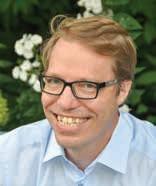
Daniel Palmowski Director of business development, Terranta, co-chair Hydrogen & Energy Storage Conference
Synergies or integration between the Hydrogen and the conferences?
The energy transition is essentially moving towards a multi-source supply chain. This means that the supply chain will be very versatile, and storage of (renewable) energy will have to adapt to the variability of supply and demand. To make this work, integration of generation, conversion, storage and consumers will be essential. I do not see the need for synergies, but rather the need for integration.
How do hydrogen and storage contribute to global sustainability goals?
Energy storage is key to supporting a continuous supply. Unlike fossil fuel storage, we are reversing the problem: during surplus periods, we convert excess energy (electricity, heat) into hydrogen, which might not be immediately needed. Heat storage is a very important form of energy storage as there is no conversion needed. If there is a market for hydrogen, green hydrogen storage will be necessary. Efficient storage is essential for managing excess energy. The main role of energy storage in the transition is as an enabler: without it, forms of energy like heat, electricity, and hydrogen will not succeed to play a role in the energy transition. Additionally, energy storage reduces the need for extra generative capacity.
Impact of this year’s coming discussions?
I think we need to convince investors, public and private, that there is not much to worry about and to not waste time. I feel we are at a point already where we are discussing problems that might be irrelevant in the future, because we lack the real-world problems that really matter.

Sanket Bhattacharya
Seismic business development manager, Fugro. co-chair Offshore Wind Energy Conference
Synergies between the Offshore Wind Conference and the other conferences?
I see a great importance in synergies, particularly between OWF and CCUS. Some key points are: 1) Reduced carbon footprintOffshore wind farms can provide the necessary power for CCUS operations, including the energy-intensive process of capturing and injecting CO2. 2) Offshore space optimisation: By co-locating wind farms and CCUS facilities, the use of shared-offshore space will offer more optimized ways of offshore operations. The Southern and central North Sea represent such a potential example of shared-offshore space. 3) Shared infrastructure - Offshore wind farms and CCUS facilities can share infrastructure such as platforms, subsea cables, and maintenance vessels reducing the overall cost and logistical complexity of both operations. 4) Regulations & Permitting - Joint projects can streamline regulatory and permitting processes, as both wind farms and CCUS facilities often require similar environmental assessments and approvals.
How is OWF contributing to global sustainability goals?
One of the biggest drivers of the energy transition is offshore wind. Since originating in Denmark in the early 1990s, offshore wind has established a strong presence in Europe with almost half of the world’s 75 GW installed capacity. And the offshore wind sector has global ambitions to reach over 260 GW of capacity by 2030. Throughout the European Union, renewables represent the largest share of domestic energy production, with 43% in 2023 compared to 6% for gas, 3% for oil and 19% for solid fuels. This milestone in Europe’s transition to clean energy aligns with meeting many of the world’s climate change targets. So, offshore wind energy is not only pivotal but is actually one of the key critical pillars of this energy transition.
Contribute to the Technical Programme and join key stakeholders in shaping the energy transition. Submit your abstract by 15 June 2025. Early bird registration is open until 1 September 2025. Learn more at eageget.org.

EuroGeoSurvey meeting.
EAGE officials recently attended the launch event in Brussels of the Strategic Research and Innovation Agenda (SRIA) of EuroGeoSurveys, the not-for-profit
association which represents 37 European Geological Survey organisations.
CEO Marcel van Loon, with EU Public Affairs colleagues Ilaria Viezzoli and Danny Landegge, took part in the panel discussions on the future of Europe’s geological resources.
EuroGeoSurveys’ SRIA is a forwardthinking initiative designed to promote the sustainable use and management of Europe’s subsurface resources. With a strong focus on geoscientific data, it aims to support the energy transition, enhance European competitiveness, and tackle global challenges such as energy security, climate change, and resource sustainability. A key element of the project is the development of a comprehensive 3D Atlas of Europe’s subsurface, a tool that will provide
invaluable data for companies working on subsurface projects across the continent.
For EAGE, this initiative is more than just about accessing data—it aligns with the organisation’s broader commitment to European affairs and strategic collaboration with EU goals. By actively participating in such events, EAGE strengthens its role in shaping the future of geoscience in Europe, fostering connectivity among all stakeholders.
During the event, our team had the opportunity to connect with many like-minded professionals who share our vision. We look forward to continuing these discussions and welcoming them to future EAGE events. More information about SRIA can be found on the EuroGeoSurveys website.
EAGE has signed a cooperation agreement with the French association AGAP Qualité.
Created in 1992, one of the missions of AGAP Qualité is to develop methodological guides and quality standards to supervise geophysical studies, guaranteeing reliable and reproducible results for all professionals. Michel Hayet, president of the organisation, says, ‘One of our first initiatives was to publish a Code of Good Practice’.
AGAP Qualité facilitates the exchange of experiences among its corporate, institutional, and individual members by organising symposia, conferences, and thematic working groups. Topics covered include geophysics applied to infrastructure, new subsurface imaging methods, and advances in geophysical technologies for the benefit of the environment.
Hayet explains: ‘In synergy with EAGE, AGAP wishes to position applied geophysics at the forefront of future challenges, by ensuring constant updating of professional standards and integrating new technologies to meet sustainability and performance requirements.’

We look forward to collaborating with AGAP Qualité in the promotion and advancement of subsurface geophysics worldwide and are honoured to count on
its participation at the 86th EAGE Annual in Toulouse. So don’t miss the chance to visit its representatives at our Associated Societies area in the Exhibition.
Geoenergy journal is inviting submissions for a forthcoming thematic collection entitled ‘Energy targets at modern and ancient divergent settings: origins, controls, opportunities and implications’ with a deadline of 31 May.

We are seeking contributions that address the generation of geological targets in divergent tectonic settings that are of importance to the energy transition. These can involve formational processes and controls (e.g. serpentinization, magma-
tism), current applications, and/or challenges. Key targets of interest include geothermal resources, metal resources, hydrogen resources, formations that can accommodate CO2 sequestration, and other potential geological innovations. Additionally, we are seeking papers dealing with the ecological, socioeconomic, policy, and sustainability implications involved with the ethical exploitation of these energy transition targets. Contributions that can address multiple targets are encouraged. Both original research and review papers are welcome.
More information can be found on the journal website.


Dr Lee Slater from Rutgers University Newark was a guest speaker at an online meeting in February of Local Chapter Czech Republic with a talk entitled ‘Looking into the hydrology and carbon cycling of Northern Peatlands via geophysics’.
Dr Slater, author of some 230 Scopus-rated papers cited by more than 4000 other publications, summarised how near surface geophysical techniques have led to fundamental improvements in the understanding of critical zone structure and the processes associated with boreal peatland (organic sediment) systems. He then highlighted elements of his work that demonstrate how the subsurface mineral sediment archi-
tecture regulates the hydrology and carbon cycling in boreal peatland systems. Dr Slater demonstrated how geophysical techniques have been used to image and monitor free-phase methane gas dynamics in peatlands.
Finally, he showcased recent results from ongoing work where geophysics and temperature sensing methods have been combined to gain novel new insights into the role of piping in regulating peatland hydrology, possibly by channelling mineralised groundwater. The lecture was co-organised with the Faculty of Science in Prague, as a part of a regular programme of applied geology in-person and online meetings.

Key challenges and opportunities facing infrastructure-led exploration (ILX) projects were the subject of the latest Local Chapter (LC) Stavanger series of meetings, on this occasion in the form of a panel discussion.
The panel featured a distinguished group of experts: Arne Jacobsen (lead for subsurface studies and technology, SODIR), Zoë Sobisch (BD project manager, Equinor), Alastair Welbon (chief exploration geoscientist, Aker BP), Roy Davies (VP exploration and subsurface, Harbour Energy Norway), and Carly Marshall (new ventures manager, Vår Energi). With their extensive experience in ILX and Norwegian exploration, they brought diverse perspectives and deep industry knowledge. Moderating the discussion were Alexandra Zaputlyaeva and Victor Aare Madsen from the Local Chapter team.
Arne Jacobsen set the stage by introducing ILX and its growing impact on the Norwegian Continental Shelf (NCS). ILX wells are drilled in areas with existing infrastructure, allowing operators to leverage established assets and reduce costs. Over the past six years, ILX wells have accounted for approximately 80% of Norway’s exploration activity, with the remaining 20% focused on frontier areas. Jacobsen highlighted that ILX wells generally have higher success rates due to their proximity to known hydrocarbon systems, whereas frontier wells, though riskier, are crucial for long-term resource development.
Norway’s hydrocarbon system, with 50 years of robust infrastructure, provides a strong foundation for continued exploration. However, ILX wells typically target smaller reserves, necessitating a strategic approach, often integrating multiple prospects across different stratigraphic levels to maximise success. Advances in seismic data quality and resolution are improving the characterisation of complex reservoirs, allowing geoscientists to make more informed decisions. Panellists emphasised that accelerating data integration through AI and automation could further enhance efficiency, freeing geoscientists to focus on high-value interpretation and validation.
One of the biggest concerns surrounding ILX is the ageing infrastructure. Panellists stressed the importance of balancing ILX with frontier exploration to ensure long-term sustainability. Collaboration between companies is becoming increasingly essential, fostering shared knowledge and risk mitigation strategies. The panel also underscored the need for young geoscientists with fresh ideas to drive innovation and help shape the future of exploration.
Digitalisation emerged as a key enabler in optimising oil and gas operations. AI-driven technologies are transforming seismic interpretation, reservoir modelling, and predictive maintenance, leading to cost reductions and improved efficiency. However,
panellists acknowledged that adopting AI requires not only technological advancements but also a cultural shift within organisations. New skill sets are needed, and geoscientists must adapt to increasingly data-driven workflows. Energy transition was another pivotal topic. While oil and gas remain integral to the energy mix, there is growing momentum toward carbon capture, utilisation, and storage (CCUS), as well as offshore wind developments. The discussion acknowledged that achieving net-zero targets will require industry-wide collaboration, regulatory alignment, and continued technological innovation.
Navigating the evolving regulatory landscape also presents both challenges and opportunities for exploration companies. Panellists discussed how shifting political priorities and environmental policies influence investment decisions. While Norway continues to be a favorable environment for energy investment, companies must adapt to increasing transparency and sustainability expectations.
The panel discussion was both insightful and highly interactive, with strong audience engagement throughout. It exceeded expectations in reinforcing the importance of such gatherings for knowledge sharing and networking.
LC Stavanger has an exciting lineup of initiatives planned for 2025. To stay informed, follow on LinkedIn.
The EAGE Student Fund supports student activities that help students bridge the gap between university and professional environments. This is only possible with the support from the EAGE community. If you want to support the next generation of geoscientists and engineers, go to donate.eagestudentfund.org or simply scan the QR code. Many thanks for your donation in advance!
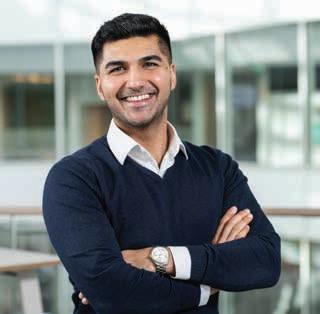
When Mahad Nadeem Janjua arrived in Europe from Pakistan he swapped economics for geoscience and went on to a Master’s degree in Europe’s prestigious IDEA League joint university programme, all supported by scholarships. Now with Harbour Energy, he has switched to data science but is also emerging as a young professional representative and digitalisation advocate at international meetings including last year at EAGE Oslo. Lifetime ‘hobby musician’, he has even busked on the streets of Hamburg.
I grew up moving around the country quite a bit because of my parents’ jobs, both being doctors. I went to private school, and my schooling years really lay the foundation for all my pursuits and passions in my life to date. I dabbled in different hobbies, from sports like football, cricket and table tennis to learning how to play the guitar, singing on stage, and even drawing and painting.
From early on in school, I had the desire to study economics in the US. But this is an expensive option for international students, so I chose a German university in Bremen for my undergraduate studies. There, my economist ambitions quickly gave way to an interest in geoscience. Much of this had to do with the very cool field trips the university programme had on offer! But I always considered myself to be good at mathematics and physics too, so specialising in geophysics seemed like a perfect blend. I applied and got accepted on a full merit sponsorship to the IDEA League Applied Geophysics Joint Master’s Programm offered by TU Delft, ETH Zürich, and RWTH Aachen.
Sponsorship from Shell for the IDEA League programme was really a big moment in life. I won the only slot for a non-EU applicant, and so I knew I had to make the most of this opportunity. It
allowed me to experience three different universities, countries, cultures, within the space of just two years. In particular, I had a lot of fun at TU Delft, where I learnt a lot about wave equations and cheese sandwiches, and started to build a professional network resulting in a summer internship at Wintershall Dea (now Harbour Energy).
After my Master’s graduation in 2021, I briefly moved to Crawley, UK, as a seismic processing geophysicist at CGG (now Viridien). Returning to Wintershall Dea, I began working as a data scientist. The motivation behind this career switch was two-fold. One, the Covid-19 pandemic and the repercussions on the oil and gas industry really highlighted the volatility in the job market prompting me to develop competencies that had applications across industries. Second, artificial intelligence was, and is even more so now, a very exciting booming sector where I could bring together my knowledge and skills to digital technology applied to the oil and gas industry. Now I work in different business units in Germany and Norway, developing digital tools and products to optimise workflows for subsurface specialists.
I have had numerous opportunities to visit places, attend conferences, and meet highly skilled professionals as part of my work. In August 2024 as part of the ONS conference in Stavanger, Norway, I had
the opportunity to participate in a round table discussion with the Crown Prince of Norway and professionals from around the world to discuss how digital technology can play a role in addressing energy poverty and climate injustice. Being invited to a leadership development programme at Oxford, UK, was a recent highlight.
Young professional perspective
I am a strong believer in driving change from within. Efforts for energy security and affordability need to be appropriately balanced with efforts towards energy sustainability, and I believe that as a young professional looking to contribute meaningfully, this industry has and will continue to offer a lot.
Outside work, I am a passionate hobbyist musician. It runs in the family. My father was a vocalist in a band back in his day, so were my brother and sister in their school days. I was a a vocalist and rhythm guitarist in school bands, and at university played solo and band shows. At the beginning of my career in Hamburg, I also explored busking/street performing for a while.
Having been a performer all my life, being on stage comes naturally. I often have the opportunity to speak at conferences and other events and really enjoy being able to contribute something of value. I also learn a lot from exchanges with the audiences.
BY ANDREW M c BARNET

Main sponsor of our Annual in Toulouse in June is TotalEnergies which last year celebrated 100 years in business, a period in which the oil industry and its role in society have witnessed a roller coaster of fluctuating fortunes and public sentiment. The company’s current challenge in a world plunged into economic turmoil is how to navigate through the uncertain world of energy transition.
The history of the company’s origins dates back to France’s experience during the First World War and French Prime Minister Georges Clemenceau’s understanding of the strategic importance of access to sources of oil. France in 1917 came within three months of running out of oil before the US answered its call for help.
Daniel Yergin notes in The Prize that before the war Clemenceau allegedly commented, ‘When I want some oil, I’ll find it at my grocer’s’. By the time Britain, France and the US were dividing the spoils of victory in 1918, a converted Clemenceau was clashing with Britain’s prime minister over a share of oil in Mesopotamia, essentially today’s Iraq, at that time controlled by the Turkish Petroleum Company (TPC), a British dominated consortium led by Shell. The San Reo Agreement in 1920 awarded France 25% of the oil in Mesopotamia (which was to become a British mandate under the League of Nations). Britain allocated to the French the share in TPC previously held by the German Deutsch Bank. It had sequestered the stake in 1915 with the promise of handing it over to France at the end of the war.
duction of five American companies and signing of the so-called Red Line Agreement (1928) governing the exploitation of oil and gas resources in the prescribed area, based on the former Ottoman Empire, a deal that persisted for 20 years. In France, CFP under Mercier then won a major political struggle to set up refining capacity run by Compagnie française de raffinage (CFR) at Gonfreville in Normandy and La Mède, near Marseille, to receive Middle East crude and remain a private enterprise (although the government did increase its share to 35%, not to be diluted until decades late).
These developments had not quite been the intention in the original 1923 mission outline statement from Poincaré. He commissioned CFP to get involved in ‘any enterprise active in whatsoever oil producing region’ and ‘co-operate, with the support of the Government, in . . . exploiting such oil wealth as may be discovered in France, her colonies and her protectorates.’ Significant expansion would only come after the Second World War.
In fact during the war CFP was fortunate to retain its investments in IPC which were vulnerable once France came under German occupation and the Vichy administration.
‘Not quite the intention in the original 1923 mission outline statement ’
It was left to Clemenceau’s successor Raymond Poincaré to invite Ernest Mercier, already active restructuring France’s electrical power generating industry, to form Compagnie française des pétroles (CFP), a private sector company in which the state would initially be a 25% stakeholder (a percentage which has changed over time).
In the run up to the Second World World period, CFP was heavily dependent on Middle East oil beginning with supplies from the 1927 first major Baba Gurghur discovery in Iraq. TPC soon became the Iraq Petroleum Company (IPC) with the intro-
Post-war, CFP embarked on a significant expansion. It faced growing local competition from newly created French energy organisations as a result of intervention by President Charles de Gaulle. This culminated in the development of what was to become Elf Aquitaine, a rival integrated energy conglomerate on a global scale, that ended in a merger in 2000.
The dramas experienced by these two companies in the history of France’s energy industry, including numerous corporate changes, are hard to encompass here. In its website history from the 1950s up to the end of the 20th century as it built into a major international integrated oil company, TotalEnergies points to some highlights in its evolution that it obviously views as significant. These include the 1956 discovery of major hydrocarbon deposits in the Algerian Sahara including the construction of the world’s first natural gas liquefaction plant, an ongoing business for the
company ever since (the history of the complications of partners and Algerian independence are not discussed); the 1969 entry into the offshore Indonesia through acquisition of two licences held by Japanese company Japex; acquisition with Enterprise de recherches et d’activités pétrolières (ERAP) of an interest in Antar, specialist in lubricants and motor oils with refineries and over 5000 service stations; partner in 1971 discovery of Ekofisk gas field in North Sea; taking control in 1974 of Hutchinson rubber processing company; and the 1982 world record drilling of a deepwater well to a depth of 1714 m, 100 km off the Rhone delta, forerunner of today’s deep offshore drilling.
In 1999 Total followed the trend of industry consolidations by merging with Belgian company Petrofina, and the following year in a hotly contested takeover battle acquired Elf Aquitaine. With more than 132,000 employees, a turnover of €114 billion, and production of 2.1 million barrels per day, TotalFinaElf (soon shortened to Total) became the world’s fourth-largest hydrocarbon producer. With 17,500 service stations worldwide and a refining capacity of 2.6 million b/d, it also became Europe’s number one downstream operator. And the new group was the world’s fifth-largest producer of chemicals. Fortuitously, Elf Aquitaine four years earlier in 1996 had discovered the massive Girassol oil reserves in Block 17 offshore Angola to be followed by a succession of other finds.
stance in the US causing the company to pause projects off the US East Coast.
In a recent highly quotable interview in McKinsey Quarterly Patrick Pouyanné describes walking a tightrope by committing to a shift of a fifth of its business to renewable-led intergrated power by 2030 stating this is considered ‘not enough oil and gas’ for traditional investors and not ‘enough renewables’ for green stakeholders.
The French company claim to a leadership role in energy transition rests on its record to date, superior annual spending on energy transiton of $5 billion and the ambition of its 2030 objectives.
‘TotalEnergies climb into the top ranks of the majors’
How Elf (now a TotalEnergies brand of oils, notably visible in motor racing) got to be such a major player was down to the forming in 1939 of the agencies Régie Autonome des Pétroles (RAP), Société Nationale des Pétroles d’Aquitaine (SNPA), and Bureau de Recherches de Pétroles (BRP) in various roles initially to exploit the Saint Marcet gas field and later near Lacq in south-west France. RAP and SNPA expanded into French dependencies including Algeria after some famous disappointments), Congo and Gabon.
These all eventually morphed in 1976 into Elf Aquitaine (now with petrochemical, plastics and pharmaceutical interests) in which the French government had a majority stake until the mid-1990s. The latter years of the company were marked by a controversial acquisition spending spree and tainted by the Great Oil Sniffer Hoax losing $150 million in 1979 and a later huge corporate corruption and kickbacks scandal involving more than $400 million in illegal payments.
In the intervening years since 2000 TotalEnergies has climbed into the top ranks of the majors. Adjusted net income in 2024 was $18.3 billion with cashflow of $29.9 billion achieved with nearly a 15% return on average capital employed in 2024, the best among the majors for the third consecutive year. Having ridden the 2008 financial crisis, the 2013/14 oil price shock and the Covid pandemic, it has had to deal with unfounded accusations that its assets (with unrealisable dividends) have been used to fuel Russian war planes in Ukraine hostilities. Then there is President Trump’s unsettling administration including an anti-wind power
In the past, Total has made key moves like acquiring Saft Groupe, the world leader in the design and production of high-tech batteries for industry; taking a 60% stake in Sunpower, America’s second-largest manufacturer of solar panels; and acquiring Direct Energie, France’s third-largest supplier of green gas and electricity. Among recent initiatives, the company agreed a 300 MW renewable energy agreement in Oman, is collaborating with Air Liquid to decarbonise its refineries in Northern Europe with green hydrogen, and with its partners launched the second phase of the Northern Lights CCS project in Norway. It also closed its acquisitions of VSB Group, a European wind and solar developer with extensive operations in Germany, and SN Power, which develops hydropower in Africa, particularly Uganda.
The big picture is that TotalEnergies plans on 100 TWh of electricity generation by 2030 with significantly increased renewable production, especially solar and wind, and will expand its flexible assets including CCTG and storage. Other tragets are 1.5 Mt of sustainable aviation fuel by 2030, 40% net reduction in Scope 1+2 emissions in 2030 (already -26% in 2024 and -36% in oil and gas), and 25% lifecycle carbon intensity reduction of energy products sold (-16.5% in 2024 vs 2015). The full story can be found in the company’s extremely comprehensive 2025 Sustainablity and Climate 2025 Progress Report
For 2025 the company foresees a net investment budget of between $17 billion and $17.5 billion. However, the portion allocated to low-carbon energy is being reduced from $5 billion to $4.5 billion, particularly in the electricity sector. This reflects a trend among other European oil majors like Shell, bp, and Equinor, all of whom have scaled back their commitments to renewable energy. CEO Pouyanné justified this pragmatic shift by pointing to the declining profitability of low-carbon energy, explaining that energy prices were less volatile in 2024 compared to the exceptional levels of 2022 and 2023. Declining refining margins were also a factor.
Predictably environmental groups were not happy that the company increased its dividend to shareholders. However, even they would be churlish to denounce the company’s 2021 rebranding to TotalEnergies and the implied aspirations.
Views expressed in Crosstalk are solely those of the author, who can be contacted at andrew@andrewmcbarnet.com.








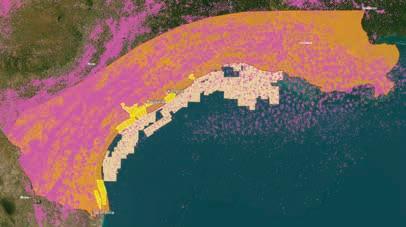

TGS has warned of a potential global installation shortfall of 26 GW of global wind capacity by 2035 on previous forecasts as a result of the US’ shift in policy. Its latest Quarterly Market Overview Report said: ‘The withdrawal of a major market like the US has significant implications globally, with developers and members of the supply chain forced to rethink investment strategies. Another key topic shaping the industry is heightened security concerns across global supply chains, driving a strategic shift toward localised manufacturing.’
Despite these challenges, floating offshore wind continues its upward trajectory, with new auction awards defying broader market uncertainty, says the report. It forecasts installations to grow from the current 0.5 GW to 26.5 GW by 2035. ‘The technology remains resilient,
benefiting from innovation and governmental support, particularly in Europe and the Asia-Pacific region,’ said TGS.
However, leading developers’ ambition overall shows signs of weakening due to increasing financial pressures and regulatory uncertainties. The report reveals that up to 70 developers will begin construction on their first project by 2030, showing a new wave of smaller, often more local, players.
‘We enter the second half of the 2020s at a turbulent time, with political uncertainty becoming ever more consequential,’ said Patrick Owen, lead author of the report. ‘As major developers’ ambitions waver, smaller and newer players are taking on greater roles in meeting national targets. Security risks also remain a hot topic. In this evolving landscape, having access to reliable intelligence is more important than ever.’
Meanwhile, TGS unveiled its MDE platform last month, which used wind and metocean data model to tackle critical inefficiencies in offshore wind data management, and replace manual handling which currently consumes up to 50% of project timelines.
Industry experts and offshore wind developers collaborated to design the MDE, integrating proprietary, public and multi-client datasets, or commercialise unused wind and metocean measurement data from past projects.
‘The Measurement Data Ecosystem is the result of an industry-wide effort to streamline data workflows,’ said Will Ashby, EVP New Energy Solutions at TGS. ‘By simplifying data access, reducing manual handling, and integrating automated workflows, we are giving developers the tools to make more confident decisions.’
Jens Riechert, an in-house expert on measurements at EnBW, who contributed as an industry adviser, said: ‘The lack of transparency and data integrity in offshore wind measurements has been a real industry challenge. It is encouraging to see a platform developed with input from industry experts to address these issues.’
TGS has also been collaborating with Equinor to shape the MDE platform’s approach to improving data management efficiency by reducing manual processes and enabling API-based, high-integrity data streams.
Viridien has won a contract from Groupement Hassi Bir Rekaiz, a Sonatrach and PTTEP joint venture, to reimage two legacy 3D seismic data sets totalling 2400 km2 in the Hassi Bir Rekaiz concession in the Berkine Basin, Eastern Algeria.
During the 13-month project, Viridien scientists are completely reimaging and merging the two legacy seismic
datasets, originally acquired in 2011 and 2013. To meet the client’s challenging imaging objectives, Viridien is applying the latest technology to deliver more detailed seismic velocity modelling and improved reliability of seismic amplitude, phase and frequency attributes for quantitative interpretation and enhanced fault imaging.
Peter Whiting, EVP, Geoscience, Viridien, said: ‘Another award from Algeria shows client confidence in our experience and differentiation in this growing market. We continue to develop and refine our technology, allowing us to extract more and more useful information from seismic data. This allows our clients to do much more with the survey data they already have.’
STRYDE has sold its first Mini Seismic System in Latin America to Energy Geophysical Services SAS (EGS) in Colombia.
After EGS’ deployment of STRYDE’s seismic technology across mining, civil engineering and oil and gas exploration surveys in 2024, EGS will integrate the mini-system into its operations for upcoming geophysical projects in Colombia.
Launched in Q4 2024, STRYDE’s Mini System is a compact, all-in-one nodal seismic acquisition solution designed for recording and producing
seismic data deliverables from up to 1500 nodes (channels). ‘With industry-leading cost per channel, it makes seismic acquisition more affordable, enabling efficient survey design that helps to optimise field operations,’ said STRYDE in a statement. ‘The Mini System leverages STRYDE’s ultra-lightweight, compact, and autonomous seismic nodes to capture high-resolution subsurface images with minimal environmental impact— empowering EGS to expand into new exploration opportunities.’
‘The adoption of STRYDE’s nodal
technology in Latin America has grown rapidly over the past three years, with successful deployments in Mexico, Brazil, Chile, Colombia and Bolivia. This latest sale is a testament to the region’s increasing demand for technology that delivers faster, more precise subsurface imaging,’ said Víctor Villamizar, head of business development – Latin America, Caribbean and Angola at STRYDE.
Rodolfo Ardila, managing director at EGS said: ‘We’re excited to be the first in Latin America to adopt this cutting-edge Mini Seismic system.’
Namibia’s offshore oil and gas industry is set for significant growth in 2025, driven by new licensing opportunities, seismic acquisition and drilling of seven wells. Development is accelerating on two of Namibia’s most significant discoveries. TotalEnergies’ Venus project in Block 2913B remains on track for a final investment decision (FID) in 2026, with new seismic data confirming better density and permeability compared to surrounding blocks. On Galp’s Mopane discovery, 3,500 km2 of high-density seismic data have been collected to refine volume estimates and advance the project toward FID.
On Shell’s PEL 39 discovery – where the company recently wrote down $400 million – Shell and its partners are analysing data from the nine wells drilled so far.
‘The scale is enormous – there’s 220,000 Km2 of offshore licence acreage,’ said Ian Thom, research director for Sub-Saharan Africa upstream at Wood Mackenzie. ‘With just over 20 exploration and appraisal wells drilled, this area is still hugely underexplored.’
‘The resources are definitely there,’ said Verner Ayukegba, senior-vice president of the African Energy Chamber. ‘The big questions now revolve around sub-surface conditions, gas content and how best to commercialise these discoveries.’
BW Energy plans to drill at the Kharas prospect within the Kudu licence, while Rhino Resources is awaiting results from two high-impact wells in PEL 85. In South Africa’s Orange Basin, TotalEner-

gies is expected to drill in Block 3B/4B, and Shell may drill in an ultra-deepwater block near the maritime boundary with Namibia.
Namibia’s petroleum commissioner Maggy Shino said the country was awaiting applications from its latest licensing round.

Equinor’s annual report has reported equity production of liquids and gas of 2067 mboe per day in 2024, on par with the year before. Equity production of renewable power increased by 51% to 2935 GWh.
Return on average capital employed was 21% for 2024. Organic capital expenditures were $12.1 billion.
On the Norwegian Continental Shelf, Equinor acquired 39 licences and received approval of the PDOs for the Eirin, Irpa, Verdande and Andvare projects. The Johan Castberg FPSO arrived at the field and started preparations for startup.
The company exited from Nigeria and Azerbaijan and acquired US Onshore gas assets close to premium markets. In the UK it established an incorporated joint venture with Shell.
The renewables market was ‘challenged by cost inflation and regulatory delays’. However, in the UK the world’s largest offshore wind farm, Dogger Bank, continued to progress towards commercial start-up. Production commenced at the Mendubim solar plants in Brazil.
Through an acquisition of a 10% stake in Ørsted, Equinor has a stake in a ‘premium portfolio of offshore wind projects and assets in operation’.
In Norway, Northern Lights, the first commercial CO2 transport and storage infrastructure, was completed and is expected to receive and store CO2 in 2025. In the UK, Equinor has started executing two of the UK’s first carbon capture and storage infrastructure projects.
In 2024, Equinor achieved a year-onyear reduction of 5% in operated scope 1+2 greenhouse gas emissions, bringing the total down to 11 million tonnes CO2
equivalents. This is a 34% reduction from 2015, which is the reference year for Equinor’s ambition to reduce emissions by 50% by 2030. Throughout 2024 emissions were reduced with the partial electrification of the Sleipner field, the Gudrun platform, as well as the Troll B and C fields.
Average upstream CO2 intensity of Equinor’s operated portfolio was 6.2 kg of CO2 per boe in 2024, an improvement from 6.7kg of CO2/boe in 2023 and ‘well below the industry average’. Scope 3 GHG emissions were 251 million tonnes in 2024, on a par with the level in 2023.
Equinor improved in the net carbon intensity of energy produced (including scope 1, 2 and 3 emissions) in 2024, which is 2% below the 2019 baseline. The reduction was mainly driven by increased renewable energy production and lower scope 1+2 emissions.
The updated Energy Transition Plan, published on 20 March 2025, outlines Equinor’s strategy of creating value in the transition.
Meanwhile, Danske Commodities and Equinor were ordered by the Commission de Régulation de L’énergie (CRE) on 20 January to pay for infringement of Article 5 of REMIT Regulation prohibiting market manipulations. Danske Commodities has been fined $8.8 million and Equinor $4.4 million for manipulations committed on the wholesale market in 2019 and 2020, with regard to natural gas transmission capacity between France and Spain. ‘Equinor does not agree with the decision and will appeal the case to the Higher Administrative Court in France,’ the company said in a statement.

bp has started the process of selecting a new chair, after Helge Lund informed the Board of his intention to step down. The process is being led by senior independent director Dame Amanda Blanc. The successful candidate will work with Lund to ensure an orderly transition before he steps down in 2026.
Chevron is selling a 70% interest in its East Texas gas assets to TG Natural Resources (TGNR) for $525 million, with $75 million in cash and $450 million as capital to fund Haynesville development. Chevron will retain a 30% non-operated working interest in a joint venture with TGNR and an overriding royalty interest in the assets.
Norway’s production figures for February 2025 show an average daily production of 1.938 million barrels of oil, NGL and condensate. Total gas sales were 9.9 billion Sm3 (GSm3), which is 0.8 (GSm3) less than the previous month. Average daily liquids production in February was: 1.723 million barrels of oil, 198,000 barrels of NGL and 18,000 barrels of condensate. Oil production in February is 1.3% more than the NOD’s forecast. Total petroleum production so far in 2025 is about 39.1 million Sm3 oil equivalents (MSm3 o.e.). Total volume is 2.6 MSm3 o.e. less than 2024.
US secretary of the interior Doug Burgum has directed the Bureau of Ocean Energy Management to hold the next scheduled oil and gas lease sale in the Gulf of Mexico. BOEM’s latest estimates of technically recoverable oil and gas resources in undiscovered fields in the Gulf of America include 29.59 billion barrels of oil and 54.84 trillion cubic feet of gas.
EMGS has won a contract for a $10 million CSEM survey in India.
Sercel has launched the WiNG DFU-3C, a three-component version of its WiNG land seismic nodal solution. Features include QuietSeis broadband digital sensor and Pathfinder transmission management technology.
UK chancellor Rachel Reeves has pledged that the Jackdaw and Rosebank projects in the North Sea will get the go ahead as she stressed the importance of North Sea oil and gas to the British economy ‘for decades to come’.
Earlier this year, Scotland’s Court of Session determined that the approvals granted for Jackdaw and Rosebank were unlawful because they did not account for the greenhouse gas emissions resulting from the eventual combustion of the extracted oil and gas, known as ‘scope 3’ emissions.
This decision aligns with a prior UK Supreme Court judgment mandating that such downstream emissions be considered in environmental assessments.
The court’s ruling means that both Shell’s Jackdaw gas field and Equinor’s Rosebank oil field must undergo new approval processes that include comprehensive evaluations of their environmental impacts, particularly concerning scope 3 emissions.
Shell has signed a deal to deploy SLB’s Petrel subsurface software powered by advanced AI to deliver seismic interpretation workflows.
The deployment aims to standardise infrastructure and workflows and accelerate scalable digital solutions, helping to improve cost operating efficiencies. The collaboration will use the deployment as the foundation for integrated geoscience workflows to further advance understanding of the subsurface across the asset lifecycle.
‘With a common focus on joint innovation, including seismic interpretation for both traditional E&P and energy transition workflows, the partnership will support Shell’s digital transformation journey,’ said Rakesh Jaggi, president, digital and integration, SLB.
Revive Geoscience Services (RGS) has been selected by Iberdrola for its first offshore wind farm repurposing project in Australia.
Iberdrola Group is expanding its operations in Australia with the Aurora Green project. The Australian government has recently granted feasibility licences to offshore wind farm developers. The Aurora Green project, a 700 km² fixed-bottom offshore wind farm more than 25 km off the Gippsland coastline, aims to generate 3 GW of clean energy.
RGS, a UK geophysical services company, will reprocess multiple vintages of long-offset 2D and 3D seismic surveys, coupled with detailed interpretation and ground modelling. ‘The objective is to

deliver insights into the near-subsurface of this wind energy new frontier, said RGS. RGS will repurpose legacy seismic data to support offshore wind farm development. ‘By leveraging advanced seismic processing and interpretation techniques, the project aims to enhance the geological understanding of the site, reducing uncertainty and mitigating investment risks,’ added RGS.
TGS has started a multi-client ultra long-offset ocean bottom node data survey in the Gulf of Mexico. The Amendment 4 project will expand node coverage in TGS’ multi-client library, adding more than 1100 km2 in the Mississippi Canyon, Ewing Banks, and Grand Isle South areas.
Amendment 4 will feature TGS’ Gemini enhanced frequency source, offering lower frequency and improved signal-to-
noise for ultra-long offset OBN seismic compared to conventional seismic sources, said TGS. The advanced frequency source will enhance input data for TGS’ elastic full waveform inversion (eFWI) algorithm, resulting in more accurate subsurface imaging of the complex subsalt geology in the region, TGS added. Acquisition is scheduled for completion in Q2 2025 and final data in Q2 2026.
Kristian Johansen, CEO of TGS, said: ‘The project will deliver industry-leading subsurface imaging, enabling oil and gas operators to make more informed decisions and mitigate drilling risks.’
Meanwhile, TGS has won a shallow water OBN acquisition contract in Trinidad & Tobago. The 80-day 3D baseline contract is scheduled to commence in early Q3.
Wood has launched a centre for technical, strategic and economic energy transition solutions in Abu Dhabi. The ‘energy transition hub’ serves clients in the Middle East region, ‘bringing together the advisory and technical expertise required to deliver energy diversification and net zero goals’. Its technical experts specialise in carbon advisory, renewable energy, hydrogen, carbon capture and storage and renewable
power generation and decarbonisation at large. Wood will help clients to integrate transition solutions including flare and emission reduction and asset emissions reviews.
The launch of the hub follows critical focus on achieving regional objectives, including UAE Net Zero 2050 and Saudi Vision 2030. The initiative addresses escalating demand for sustainable energy
DNO has made an ‘important’ oil and gas discovery in Northern North Sea licence PL1182 S in which the company holds a 40% interest. The discovery was made in Paleocene injectite sandstones of excellent reservoir quality with preliminary estimates of gross recoverable resources in the range of 39 to 75 million barrels of oil equivalent (MMboe), with a mean of 55 MMboe. The Kjøttkake exploration well encountered a 41-m oil column and a 9-m gas column. It is located 27 km northwest of the Troll C platform and 44 km southwest of the Gjøa platform. Partners include Aker BP (30%), Concedo (15%) and Japex (15%).
Shell, has taken a final investment decision for Gato do Mato, a deep-water project in the pre-salt area of the Santos Basin, offshore Brazil. The Gato do Mato Consortium includes Shell (operator, 50%), Ecopetrol (30%), TotalEnergies (20%) with PPSA acting as the manager of the production sharing contract (PSC). Estimated recoverable resource volumes of the Gato do Mato development are approximately 370 million barrels.
Wildcat Petroleum has signed an agreement with The Strategic Fuel Fund Association (SFF) owned by the South African government to evaluate petroleum assets in South Sudan previously held by Petronas. The partners will explore acquisition of all or parts of the assets. The agreement expires on 5 August 2025. Both parties can terminate with five days’ notice. Petronas withdrew its operations in South Sudan in August 2024. Mandhir Singh, chairman of Wildcat said: ‘SFF is one of only a handful of companies that has signed a petroleum deal in South Sudan since the country gained independence in 2013. It has a well-established technical team in Juba which can assist Wildcat in any technical work it needs to conduct.’
APA Corporation (50%) and partners Armstong (25%), and Santos (25%), have announced preliminary results of the Sockeye-2 exploratory well. The Sockeye-2 well was drilled to a depth of approximately 10,500 feet and successfully encountered a high-quality reservoir with approximately 25 feet of net oil pay in
solutions, with capital project investment in clean energy in the region anticipated to triple within the next five years.
Gerry Traynor, president of projects Eastern Hemisphere, said, ‘With global investment in the energy transition surpassing $2 trillion, Wood’s experts will play a key role in advancing pragmatic, scalable and sustainable energy solutions for our clients and the region’.
one block, Paleocene-aged sand with an average porosity of 20%. The porosity and permeability are both better than expected. Additional zones of potential pay were also encountered in the shallower Staines Tongue formation. The Sockeye prospect is amplitude-supported across 25,000 to 30,000 acres, and confirms the partners’ geologic and geophysical models, derisking numerous additional prospects in the area.
bp has received final government ratification for its contract to invest in the redevelopment of several giant oil fields in Kirkuk, northern Iraq. The contract between North Oil Company (NOC), North Gas Company (NGC) and bp includes the rehabilitation and redevelopment of the fields, spanning oil, gas, power and water with potential for investment in exploration.
Petrobras has identified hydrocarbons in the Campos Basin pre-salt, in an exploratory well in the Norte de Brava block. Well 1-BRSA-1394-RJS is 105 km from Rio de Janeiro, at a water depth of 575 m.
CNOOC has made a big oil discovery in the deep and ultra-deep South China Sea.
The UK is investing £20 million into ‘Starmaker One’, a British fusion fund which will help fusion start-ups and is expected to leverage £100 million investment into the UK. The funding will help small fusion companies to develop technologies and capitalise on the opportunities of fusion energy in markets such as magnetics, industrial AI, robotics, healthcare, transportation and energy storage. Fusion uses the same process that powers the sun by combining two forms of hydrogen and heating them at extreme temperatures, releasing vast amounts of energy.
Two RWE projects have been successful in the latest Italian renewables auction: the 45 MW Venusia wind farm in the province of Potenza, Basilicata region and the 48 MW Serra Palino wind farm in the province of Foggia, Apulia region. The start of construction is planned for the second half of 2025, with commissioning planned for next year.
The UK has shortlisted 27 green hydrogen projects in its HAR2 application. Successful developers include: Aldbrough Pathfinder, Hygen Energy, Binn Ecopark, Green Cat Hydrogen, Hynamics, RWE Generation, Green Hydrogen 5, Grenian Hydrogen, Carlton Power, Uniper Hydrogen, Scottish Power, Lhyfe, Magor Net Zero, European Energy, Stratkraft Hydrogen, Centric, South Tees Net Zero, Four Zeros Energy, Strthallan Hydrogen, EDF, H and 2 Energy Ecosystem; Motive Fuels.
Denmark has received 16 applications for its $4.2 billion CCS fund for carbon capture and storage. The Danish Energy Agency will select 10 companies. The money will be paid out in 2029-2044.
Equinor, Shell and TotaalEnergies have made a final investment decision to progress phase two of the Northern Lights development. The decision to invest some $680 million was made after the partners signed a commercial agreement with Stockholm Exergi to transport and store 900.000 tonnes of biogenic CO2 annually for 15 years.
TGS has released the Central Gulf Coast-Haynesville CO2 Storage Assessment, the final segment of the Mega Gulf Coast Assessment offshore US.
This assessment builds on previous releases for the East Gulf Coast and Gulf Coast assessments in 2024, culminating in a dataset covering more than 16,000 key wells with core-calibrated petrophysical and stratigraphic interpretation across more than 166,370 square miles in the Gulf Coast region.
The Central Gulf Coast-Haynesville CO2 Storage Assessment integrates petrophysical and stratigraphic analysis from 2326 wells and utilises more than 150 core analysis reports to refine geological interpretations. The stratigraphic framework includes 35 stratigraphic tops, from the Anahuac Formation down to the Triassic stratigraphy to provide a detailed understanding of storage capacity, reservoir quality, and sealing integrity.

Will Ashby, executive vice-president of New Energy Solutions at TGS, said: ‘By leveraging our extensive well data library and expertise in petrophysical and stratigraphic analysis, we provide a comprehensive view of subsurface storage potential tailored to the needs of CCS stakeholders operating in the Gulf Coast region.
Cegal and Qumlo have signed an agreement to integrate Cegal’s subsurface data management and Cetegra capabilities with Qumulo’s cloud native architecture.
Qumulo’s file service platform, including Cloud Native Qumulo, Azure Native Qumulo, and Cloud Data Fabric will be merged into Cegal software.
Cegal chief technology officer John Henrik Andersen said: ‘Cegal is known for delivering energy workflows in Microsoft Azure and private clouds, especially with Cegal Cetegra. Now, integrated with the full suite of Qumulo’s cloud native services, optimised for oil and gas workloads, our customers will benefit from faster elastic performance and better economics, significantly reducing the time to decisions and increasing value.’
Qumulo president and CEO, Doug Gourlay, added: ‘With this technology, Qumulo and Cegal can offer up to three times the performance of competitive products in the cloud while delivering
improved economics. Cegal’s expertise and technology integrations in petrotechnical applications enhance this value for our mutual energy sector customers.’
Applications like Petrel, DecisionSpace, ArcGIS will be able to perform operations faster with data stored in the Qumulo file systems.
The Qumulo cloud-native architecture uses fast NVMe (Non-Volatile Memory express) and Managed Disks, as well as object storage, and supports multiple file protocols simultaneously. Qumulo Predictive Caching detects the user’s workflow, predicts what files are required by the workload next, and pre-fetches data into a cache that reduces file system latency and increases application performance.
Customers will save between 20% and 50% on the total cost of ownership for their file storage and performance environment by switching their existing cloud or on-premises solution to one designed by Cegal and Qumulo, the partners said.


Explorers have a good idea of where global hotspots are globally, but excellent multi-disciplinary geoscience strategies are need to identify sweet spots. They are focusing on areas where new sources of oil and gas are required to keep the world supplied with energy during the transition to renewables. Geoscientists are also identifying areas for carbon capture and storage, offshore windfarms, hydrogen and geothermal projects.
Mark Hamilton gives an overview of recent drilling in Egypt’s western delta as the Eastern Mediterranean emerges as a key region for hydrocarbon exploration.
Tad Choi et al put the exploration spotlight on Malaysia, Indonesia and India.
Bob Fryklund et al demonstrate why hotspots will help to provide some of the most advantaged oil and gas — lowest cost, highest margin and lowest emissions.
Carl Fredrik Gyllenhammar argues that a report showing that licence PL 993 offshore Norway has only an 18% chance of success is worth revisiting with a chance of success more closer to 50%.
Neil Hodgson et al cast their eyes on the last great global exploration play to be tackled – the counter regional dipping clastic fan play on the basin floor of the Earth’s passive margins.
Sindre Bull-Jansen et al demonstrate how quantitative interpretation techniques have shown potential AVO anomalies, providing valuable guidance for prospect identification.
Erling Franzen et al discuss how advanced geoscience technologies and data are successfully supporting global exploration.
Mike Lakin identifies plays around the world that will be looked at again in a rapidly changing global energy landscape.
First Break Special Topics are covered by a mix of original articles dealing with case studies and the latest technology. Contributions to a Special Topic in First Break can be sent directly to the editorial office (firstbreak@eage.org). Submissions will be considered for publication by the editor.
It is also possible to submit a Technical Article to First Break. Technical Articles are subject to a peer review process and should be submitted via EAGE’s ScholarOne website: http://mc.manuscriptcentral.com/fb
You can find the First Break author guidelines online at www.firstbreak.org/guidelines.
January Land Seismic
February Digitalization / Machine Learning
March Reservoir Monitoring
April Underground Storage and Passive Seismic
May
Global Exploration
June Navigating Change: Geosciences Shaping a Sustainable Transition
July Modelling / Interpretation
August Near Surface Geo & Mining
September Reservoir Engineering & Geoscience
October Energy Transition
November Marine Acquisition
December Data Management and Processing
More Special Topics may be added during the course of the year.
BY 21 JULY

14-18 SEP. 2025

2-5 JUNE 2025
86th EAGE Annual Conference & Exhibition
Toulouse, France www.eageannual.org
5-7 May First EAGE Atlantic Geoscience Resource Exploration & Development Symposium www.eage.org
5-9 May RENAG 2025 www.ageocol.org/renag
7-8 May DGMK/ÖGEW Spring Conference 2025 - Subsurface Innovations and Insights www.dgmk.de/en/events/dgmk-oegew-spring-conference-2025
8-9 May First EAGE Workshop on Land Seismic Acquisition www.eage.org
12-14 May GeoConvention 2025 www.geoconvention.com
12 May 7 th NSGE Pre-Conference Workshops - Fiber Optic Sensing for Near-Surface Applications - Landslides, Debris Flow, and Slope Stability: What is Expected from Geophysics?
13-15 May 7 th Asia Pacific Meeting on Near Surface Geoscience & Engineering (NSGE) www.eage.org
15-17 May 60 th CEEC Event ceecsg.org/save-the-date-60th-ceec-event-15-17-may-2025
Morocco
Croatia
19-22 May InterPore 2025 events.interpore.org/event/56 Albuquerque United States
21-22 May First EAGE/SBGf Workshop on Marine Seismic Acquisition www.eage.org
de
June 2025
2-5 Jun 86th EAGE Annual Conference & Exhibition www.eageannual.org
22-24 Jun AAPG/EAGE Geothermal Energy in the Middle East: Unlocking a Vast Renewable Energy Resource Beneath our Feet www.eage.org Al Khobar Saudi Arabia
24-25 Jun Innovarpel 2025 www.arpel.org/en/events
30 Jun2 Jul 4 th Carbon Capture & Storage Conference Asia Pacific www.eage.org
July 2025
3-4 Jul 5 th EAGE Workshop on Fiber Optic Sensing for Energy Applications www.eage.org
6-11 Jul Goldschmidt 2025 conf.goldschmidt.info/goldschmidt/2025/meetingapp.cgi
September 2025
1-4 Sep World CCUS Conference www.wccus.org
7-11 Sep Near Surface Geoscience Conference and Exhibition (NSG) 2025
- 31st European Meeting of Environmental and Engineering Geophysics
- 6th Conference on Geophysics for Mineral Exploration and Mining - 4th Conference on Geophysics for Infrastructure Planning, Monitoring and BIM
- 1st Conference on Geohazards Assessment and Risk Mitigation - 1st Conference on UXO and Object Detection www.eagensg.org
7-11 Sep 32 nd International Meeting on Organic Geochemistry (IMOG) www.imogconference.org Porto Portugal
9-11 Sep Second EAGE Conference and Exhibition on Guyana-Suriname Basin www.eage.org Georgetown Guyana


www.eage.org
Nov SBGf Conference Rio’25 www.rio25.sbgf.org.br












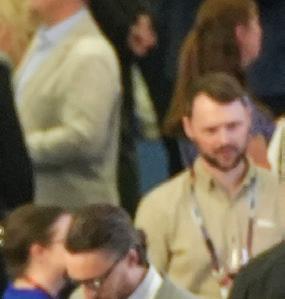



























Opening Ceremony

Exhibition











Strategic Programme
Workshops




Technical Programme

Field Trips









DTA & ETA Programme




Community Programme

Short Courses
Hackathon








Icebreaker Reception


Conference Evening

REGISTER BEFORE 15 MAY AND SAVE UP TO 22%
REGISTER NOW AT EAGEANNUAL.ORG
